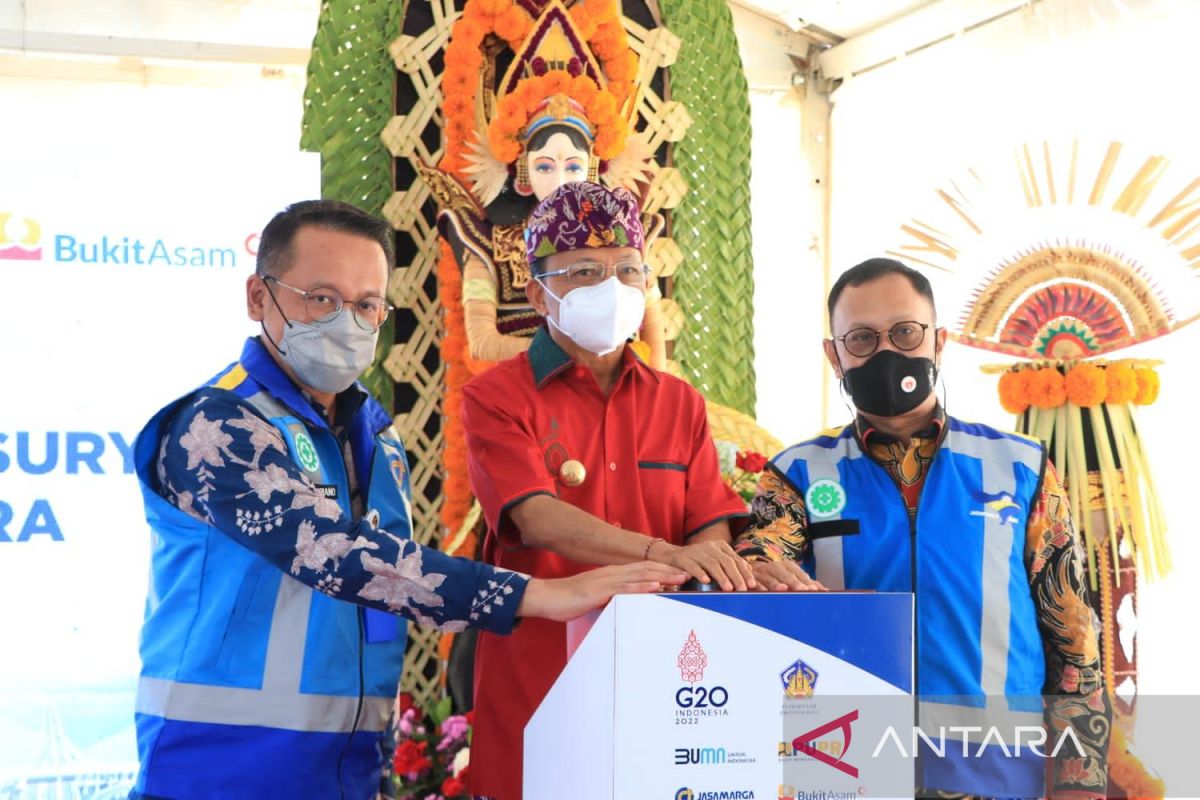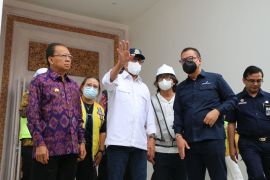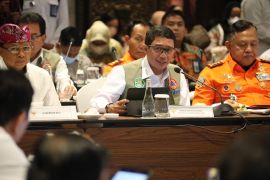Not only beautification and landscape design, but the characteristics of Bali will also be presented to the G20 guests through Balinese cultural ornaments on the public street lighting and toll gateDenpasar, Bali (ANTARA) - During a period of every 210 days, Balinese Hindus commemorate Tumpek Wayang, one of the holy days to express gratitude to God's creation in art.
In Balinese tradition, Tumpek Wayang is a day to perform rituals for art objects and types of carvings, such as puppets. Hence, people having puppets, especially puppeteers, will perform the yadnya ceremony on Tumpek Wayang Day.
Similarly, if a family has a child born in wuku wayang, one of the cycles in the Balinese calendar, they must perform ceremonies and Bayuh Oton upakara (equipment) with the staging of Wayang Sapuh Leger.
However, this year’s Tumpek Wayang, which fell on March 5, 2022, was different, as Hindus in Bali did not only conduct worship or art-related rituals.
Non-Hindus also participated in the Tumpek Wayang Day after the issuance of Bali Governor's Instruction No. 4 of 2022 on Celebration of Tumpek Wayang Day with the Kerthi Jagat Ceremony.
Related news: Indonesia to encourage migration governance through G20: Migrant Care
Bali Governor Wayan Koster remarked that the Tumpek Wayang celebration was linked to the application of the Jagat Kerthi local wisdom value that is part of Sat Kerthi.
Sat Kerthi is six attempts to realize the harmony and balance of the universe comprising Atma Kerthi, Samudra Kerthi, Wana Kerthi, Danu Kerthi, Jagat Kerthi, and Jana Kerthi.
According to Koster, the relation between the puppets and universe is the Balinese puppet show itself that is a miniature of the universality concept.
One koprak or a script told that the puppet show comprises hundreds of figures and characters that represent human life on earth.
According to the mythology of Shiva Nataraja, when the world was first created, it was in such an unstable condition that there was no life on earth.
Concerned about the unstable state, Lord Shiva in the "prabawa," or the form of Natha Raja, which translates to the great king, rotates the world with his feet and hands. He dances to create regular rhythm and harmony on earth.
Related news: Future of electric vehicles in Indonesia through the G20 Presidency
From then, life on earth has begun to exist, starting from plants, animals, and then humans.
"The success of Lord Shiva to create order and harmony on earth and for living creatures are glorified by the Jagat Kerthi Ceremony," Koster explained.
Hence, in relation to supporting the harmonious balance between humans and earth, the celebration of Tumpek Wayang in Bali was also paired with the groundbreaking construction of rooftop solar power plants on the Bali Mandara Toll Road, an exhibition of electric motor vehicles, and the performance of leather puppets in Taman Budaya, Denpasar.
"The momentum of the Tumpek Wayang celebration aligns with one of the three agendas of the 2022 Indonesian G20 Presidency, especially the energy transition," Koster stated.
For him, the local wisdom of Sat Kerthi, from the ancestors of the Balinese people, does contain universal values, so it is still deemed as necessary and relevant throughout the ages.
Discussion on the transition to green energy is crucial because it reflects the perspectives of Indonesia as both a developing and archipelagic country that is severely affected by climate change.
Related news: SOEs to build solar plant along Bali Mandara Toll Road
Energy-independent Bali
Koster, while delivering his remarks during the commemoration of Tumpek Wayang Day, stated that his team will continue to strive to realize an energy-independent Bali by using clean energy, so that the regional area will forego its dependency on Java Island for electricity supply.
"In the vision of Nangun Sat Kerthi Loka Bali, I will realize a Bali that is energy independent. Now, from Bali's electricity capacity of 1,250 MW, some 380 MW of it is still supplied from Paiton (in Java Island)," he explained.
Koster confirmed to have spoken with the energy and mineral resources minister and state electricity firm PLN's president director in order to meet the goal of electricity in Bali that uses clean energy.
In fact, he had refused a 500-MW supply from Paiton, as it would have increased Bali's dependence from outside the region in addition to its fuel that is generated from coal, which means it is not environmentally friendly.
Bali must utilize electricity power plants that are located in Bali and shift from coal or diesel fuel to new renewable energy.
Related news: Bali's Lemukih boosts tree-planting program in line with G20
Coinciding with the Tumpek Wayang Day, Bali has begun constructing the rooftop solar power plant along the Bali Mandara Toll Road, which will be the first solar plant in the history of toll road infrastructure over the sea in Indonesia.
The rooftop solar power plant construction also became a reminder and motivation for other power plants in Bali, such as those in Celukan Bawang, and Gilimanuk, to immediately switch to using environment-friendly energy in a step-by-step manner and no longer operate plants sourced from coal or fossils.
"This is part of Bali's commitment in welcoming the G20 Summit that discusses the issue of transition to green energy," Koster stated.
As a world tourism destination, Bali not only needs to be energy independent but also use clean energy from upstream to downstream, such as in offices, houses, malls, hotels, restaurants, and supermarkets, to use rooftop solar power plants.
Through clean energy utilization, the air inhaled by humans is expected to be fresher, and air pollution to be lessen, thereby enhancing public health.
The rooftop solar power plant on the Bali Mandara Toll Road, which is targeted for completion in July 2022, has a maximum capacity of 400 kWp.
Solar panels will be installed at six locations, each at the entry and exit for the motorbikes at three toll gates on the Bali-Mandara Toll Road.
The length of the solar panels on each of these locations is one kilometer. The electricity generated from this power plant will later become an environment-friendly source of electricity for public street lighting, operational offices, and also toll gates on the Bali Mandara Toll Road.
Furthermore, 750 thousand mangrove plants will be planted in the areas of the Bali Mandara Toll Road.
The work of designing the landscape and beautifying the Bali Mandara Toll Road also continues to be conducted, such as making gardens and planting ornamental plants in some parts of the toll road.
"Not only beautification and landscape design, but the characteristics of Bali will also be presented to the G20 guests through Balinese cultural ornaments on the public street lighting and toll gate," state toll road company Jasa Marga Business Director Reza Febriano stated.
Related news: G20 schedule: Ministry to open DEWG forum next week
Related news: Indonesia initiates monitoring tools for labor market inclusiveness
Editor: Fardah Assegaf
Copyright © ANTARA 2022












